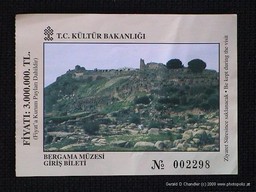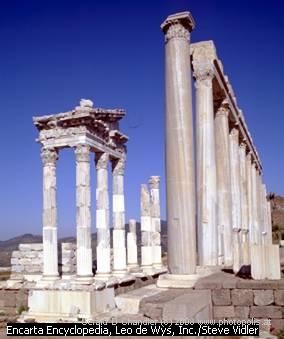Home | Front Page | Blog | Index | New | Contact | Site Map
Antalya (April 1-8; 12-15)
Kalechi
Perge
Aspendos
Termessos
East of Antalya (8-12)
Side
Anamur
Antioch Ad Cragum
Alanya
Lycia (15-25)
Tekirova -
Phaselis
Myra(Kale)
Kekova
Kas
Xanthos
Fethiye
Kara - Oludeniz
Lycian Way
Datça Peninsula (25-2)
Greek Cities (May 2-18)
Selçuk -
Ephesus
Izmir -
Smyrna
Bergama -
Pergamon
Ayvalik
Assos
Troy
Ataturk Country (17-24)

Egypt
Israel
Turkey
Bulgaria
Romania
Ukraine
Poland
Prague
Britain
USA 2002
Travel Map
Sadly, the picture of our entrance ticket is the only one that Gerry took on our visit to Pergamon. The power supply to both of our computers had failed and so he could no longer transfer his photos from memory stick to computer. Even with two memory sticks each of 64 MB set to take photos at the lowest resolution, he still only had capacity for a few hundred pictures. Since he normally took 50-100 pictures a day, and his computer was out of use for almost two months, you can see that he was in quite a pickle.

Pergamon Ticket |
The ticket shows the ancient site of the city of Pergamon, on a hilltop overlooking the modern Turkish city of Bergama. Pergamon was founded by one ofAlexander's generals and so was a Greek-speaking city that like so many others ultimately passed into the hands of the Romans.
It is most famous of course for the temple of Zeus whose remains are now in the Pergamon Museum in Berlin, which we visited in 1974 when the museum was in East Berlin under Communist rule. We must have the photos, or more likely slides, to prove it. But they are doubtless stashed away in our storage locker in New Jersey. Some future update will perhaps include them!

Ruins of Pergamum
The ancient city of Pergamum was an important center of Greek culture, housing an impressive library and an altar to Zeus. The city was the capital of the kingdom of Pergamum. It first acquired prominence in about the 3rd century bc and was ruled by the Attalus dynasty before coming under Roman control in 133 bc. Today its ruins surround the town of Bergama, Turkey.
Encarta Encyclopedia Incİ 1993-2003 Microsoft Corporation. All rights reserved.
We took a rather unorthodox approach to the site, deciding to climb to and descend from the site on foot. It is one of Gerry's beliefs that only on foot can one really know the scale of things. We climbed up through the village that hugs the lower hillside then started looking for a lower entry gate. Not finding one we continued on up following the road, which gave us some wonderful views of the valley, and some mouthfuls of diesel fumes from the tourist buses. But the view from the top made it all worthwhile, even the heel sores that Jan suffered were minor compared with the view that greeted us from the top. Here was indeed a magnificent site. Way off in the distance we could make out the Asklepion, an ancient medical center on a lower hill a mile and a half away that we had visited the previous day. The top of the hill was where the Temple of Zeus once stood but now there is nothing left but the outline of the foundation, its remains now housed in the famous Pergamon Museum in Berlin, Germany.
We should perhaps digress here to talk a little about the relics sitting in Britain, Germany, and elsewhere. The Greeks and the Turks make much of pointing out such "thefts" and angrily demand their return. In general, we believe that these relics might indeed have been taken without government permission, but that is because the government of the time cared little for them. The Ottoman government in particular was Islamic and had little regard for these Graeco-Roman remains. These items have been very well preserved, are on public display to all who wish to come and see them and probably do more to enhance the reputation of modern Greek and Turkish forbears than any modern P.R. firm could want. Perhaps one day, when the quality of museums and curatorship has reached western standards it will be appropriate to return some items. But not all. End of digression.
The most impressive feature was in some ways the most commonplace of all — the theater. But what a theater! It must be the steepest Greek theater ever constructed. We entered it from the top and it dropped straight down several hundred feet. It was breathtaking. We sat and admired this feat of architecture for twenty minutes and then slowly stepped our way down, down, down, to the stage level and then on down through the ancient city which stretches down the hillside towards modern Bergama.
Arriving at the final gate, through which you are forced to take a winding path, the better to deter attackers, we discovered why we hadn't found a way in earlier in the day: the way in was through a break in the fence.
http://www.kusadasi.com/pergamon.html